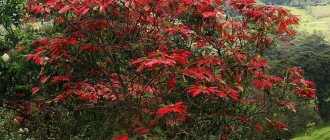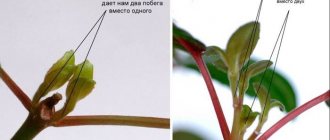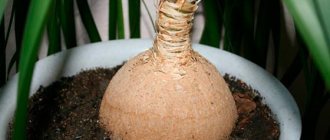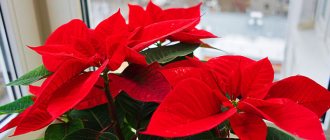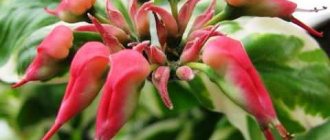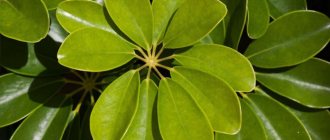Poinsettia (lat. Poinsettia), or beautiful spurge, is called by many gardeners the “Christmas star”. The evergreen shrub is native to Central America and the tropics of Mexico. In its native open spaces, the plant often has a height of 4 m, while on window sills its dimensions are quite modest - 30-50 cm.
Poinsettia appears on the shelves on the eve of the New Year holidays, so bouquet bushes with bright variegated leaves are considered a symbol of Christmas. Small yellowish milkweed flowers are framed by pink, red, and white bracts, sometimes mistaken for the flowers themselves.
Interesting! Among the Aztecs, the plant was considered a symbol of purity. Its juice was used to treat bodily ailments, used for tattooing, and dyed fabrics.
Another name for the bush, “Star of Bethlehem,” appeared thanks to biblical legends: bare branches were brought by poor children as a gift to the newborn Jesus. In the morning, red stars appeared on the branches. To this day, altars are decorated for Christmas with beautiful milkweed.
Features of cultivation
The charming Star of Bethlehem leaves no one indifferent - bright and colorful, it inspires, improves your emotional state, and lifts your spirits on long winter days.
For long flowering, very little is required - careful and proper maintenance :
- Lighting. Poinsettia actively develops in diffused but bright light. But he doesn’t like direct burning rays.
- Humidity and temperature. The flower needs warmth and regular spraying when flowering.
- Watering. The soil is kept moist, but stagnation of water in the pan is unacceptable. Likewise, a lack of moisture will cause leaf fall.
- The soil. The shrub grows well in slightly acidic soil, but also responds positively to neutral soil.
- Feeding. From the growing season until flowering, poinsettia should receive feeding twice a month. During flowering, not all gardeners feed it - this is at their discretion.
- Transfer. With annual replanting, a one-time flowering plant, as it is sold in stores, will become a perennial.
- Trimming. Sanitary and decorative pruning will greatly improve the condition and appearance of the bush.
It is important for the flower to provide optimal lighting and timely watering.
The annual cycle of the plant consists of 4 main periods , each of which requires certain care:
- Peace. The Christmas star rests after flowering for 2-2.5 months: end of winter - beginning of spring. Minimal care.
- Vegetation. In April, poinsettia wakes up and actively develops.
- Budding. Intensive growth stops, the plant forms buds. The period is the most crucial for the florist.
- Bloom. The brightest stage of flower development occurs during the New Year holidays. Care during this period is not difficult.
Caring for poinsettia at home
Poinsettia after purchase
Blooming poinsettia is usually purchased on Christmas or New Year's Eve as a gift or temporary decoration, and after flowering is over, it is disposed of. The period of adaptation of the plant to the conditions of your apartment may not be easy, so when purchasing, carefully inspect the plant for the presence of pests and signs of disease and do not be shy to smell the soil in which the poinsettia grows: if it smells of mold or rot, do not buy the flower.
Do not buy poinsettia at street New Year's markets if the air temperature drops below 5 ºC: when you bring the flower home, its leaves will begin to fall off, and the poinsettia will soon die. You can transport the plant in the cold only by wrapping it entirely in paper.
There is no need to replant your poinsettia after purchase, but if you want to see milkweed bloom again, be prepared for the fact that it needs special care, taking into account its tropical origin. And if you create conditions close to natural for poinsettia, it will bloom regularly on your windowsill for 3-4 months for many more winters.
How to care for poinsettia
Household poinsettia, like its wild relative, is a heat-loving plant: for normal development it needs a temperature within 12-25 ºC. It does not tolerate heat above 25 ºC. Dry air also harms the plant, so milkweed will need frequent spraying (1-2 times a day), especially in winter, when heating devices operate at full capacity. A good way to humidify the air around the plant is to place the poinsettia pot on a wide tray of wet pebbles.
Both drafts and cold are detrimental to the most beautiful milkweed: if you keep it on a windowsill in winter, make sure that the leaves do not touch the glass.
Poinsettia at home prefers southern, eastern or western window sills, but for winter the ideal place is a south-facing window, provided that you provide shading for the milkweed during the midday hours.
Watering poinsettia
Water the poinsettia as the substrate dries: in summer the soil is moistened more often, in winter - less often. Water for irrigation should be settled and slightly warmer than room temperature. Overmoistening the substrate can lead to rotting of the roots, and in this case, the plant can only be saved by replanting it in a fresh substrate, previously spilled with a solution of potassium permanganate.
Feeding poinsettia
Starting in spring, every two weeks poinsettia is fed with complex mineral fertilizers, which can be alternated with a weak solution of mullein. When flowering begins, the plant will need potassium supplements for decorative flowering indoor plants.
Preparing poinsettias for flowering
In order for the formation of flower buds to occur, it is necessary to create conditions for the poinsettia that are close to natural, namely, ten-hour daylight hours for two months. In our climate zone, the days are longer at this time of year, so you need to cover the plant with a cardboard box or a dark, opaque plastic bag from 18:00 to 8:00. During this two-month period, milkweed is fertilized with fertilizers for ornamental flowering plants weekly, but the concentration of the solution should be one third weaker than suggested in the instructions.
Problems when growing a flower
Poinsettia breeders sometimes encounter problems not related to diseases or pests:
- Yellowing of foliage. Frequently watering a flower, at the minimum permissible temperature, can cause rotting of the roots. The bush becomes sick and the leaves turn yellow, indicating a problem. The flowerpot is moved to a warmer room, sand is poured into the tray to help remove moisture. If the leaves are yellow for more than a week, then it is advisable to transplant the bush into a smaller flowerpot, removing the affected roots.
- Leaf fall. If abscission occurs at the end of flowering, the poinsettia is preparing for dormancy. Also, leaf shedding will be observed due to insufficient watering, with a sharp temperature change. You should inspect the bush more carefully and correct any shortcomings.
- Lack of flowering. Omission of agrotechnical recommendations postpones flowering for an indefinite period. It is necessary to reconsider the care, check the temperature and light intensity.
Propagation by cuttings
If you have a healthy and strong poinsettia that you want to propagate from cuttings, get started using our step-by-step instructions:
- A mother plant with strong and strong shoots is selected.
- Cuttings are cut, 7-10 cm long, with 4-6 internodes.
- The lower leaves are removed, if the upper ones are very large, their leaf blades are shortened by half or leaving only a third.
- The bottom cut is made directly under the last internode. It should be straight and smooth, using a good sharp knife, scalpel or blade. You cannot cut cuttings with scissors - they crush tissue and squeeze the conducting vessels of the plant.
- After cutting, all poinsettia cuttings must be kept in fairly hot water (about 40 degrees). Do not dip the plant in boiling water - it will die, but it is useless to keep the cutting in too cold water. Keeping the cutting in liquid is necessary so that the latex juice, which is so rich in all milkweeds, flows out and does not block the vessels of the cutting. Only in this case can you count on the plant to take root. The duration of the procedure is at least 15 minutes, but you can hold it longer.
- While the cutting is standing in water, you can prepare a substrate or container where it will take root. This can be any opaque container. To prepare the soil, take an equal mixture of turf, leaf and peat soil, adding the same amount of washed sand. The composition is mixed well, sifted and filled into containers for growing. Be sure to provide good drainage, otherwise the cuttings may rot.
- Prepared containers for planting are watered.
- The cuttings are planted in the ground to a depth of 2-4 cm, depending on the size of the cut shoot.
- The plantings are covered with a transparent film to retain heat and moisture. If the cuttings are planted in separate pots, they can be covered with individual plastic bags. Don't forget to make small holes in the film or bags to avoid moisture stagnation and lack of fresh air.
- From time to time, the plantings need to be ventilated, monitor their condition and soil moisture level, and spray to increase air humidity.
- Containers with cuttings should be placed in a fairly bright and warm place, but be sure to protect them from bright sunlight and temperature changes.
- Rooting usually takes about a month. The swelling of new buds and the formation of leaves indicates the appearance of roots. After some time, when the cuttings give strong, healthy roots and the shoots are sufficiently elongated, you need to start pinching and forming the future plant. A strengthened and beautiful bush is transplanted into the same soil mixture and regularly watered, fertilized and sprayed.
Diseases and pests
Poinsettia rarely gets sick. All problems with her health arise due to non-compliance with agricultural practices. A deficiency of fertilizing, as well as excess or irregularity, temperature changes, poor-quality lighting, and unfair watering, turn into a blow for the plant:
- The stems droop, exposing the core;
- The leaf turns brown, turns yellow, falls off;
- The roots rot;
- The flower becomes covered with spots.
Poinsettia is most vulnerable to the following diseases :
- Gray rot, stem, root. The stems and inflorescences are covered with a gray coating, brown spots on the foliage. The flower is treated with Celandine, Skor, Fundazol.
- Powdery mildew. The white coating covering the bush gradually turns brown. Copper sulfate, Celandine, Skor, Topaz are used for treatment.
- Fusarium. The above-ground mass turns brown, then turns black. Withered greenery quickly dies. For processing you will need Fitosporin-M, Funlazol, Topaz.
Insect pests
Insects appear on hot days, especially when the plant lacks watering and moisture. Pests from other flowers can also move in. They are often caught with plants brought in from the street.
| Insect | Sign | Struggle | Prevention |
| Thrips | Black-brown parasites nest on the underside of the foliage, and it turns silvery-white and dries out. The stems are deformed. | Damage is removed, treated with decoctions of onions and marigolds. Dantop, Apache, Virom, Aktaru are used. | Maintain high humidity, place flypaper nearby. |
| Spider mite | The thin threads that weave around the petioles are difficult to notice, but the presence of the parasite is revealed by translucent spots on the foliage. | The soap-alcohol solution is applied for half an hour, then washed off with hot water (+40…+45). Treatment of the bush, soil and pot with Sunmite, Apollo, Actofit, Neoron. | Increase humidity, treat with infusions of garlic, onion, and tobacco. |
| Whitefly and aphids | The stems become thinner, the leaves become deformed and curled. | Admiral, Decis, Aktara, Fury. | New plants are kept in quarantine. Brought bouquets are kept away from indoor flowers. Treated weekly with decoctions of citrus skins, pine needles, and strong-smelling herbs. |
| Mealybug | The petioles, the bases of the shoots, and the undersides of the leaves are covered as if with dirty cotton wool. The greenery of the bush is sticky and deformed. Visible marks are removed with a soapy cotton swab. | The bush is treated with Fitoverm, Aktara, Aplaud. Watering and spraying with a decoction of horsetail, calendula, cyclamens. | Wiping and inspecting the bush. Maintaining optimal humidity, treating with infusion of onion or garlic. |
Video about the features of growing poinsettia
The author of the video explains how to make a plant bloom every year. Features of flower pruning - when and how it should be done. How to feed poinsettia for good growth and abundant flowering. Join the viewing!
If you approach the care of the Christmas star wisely, growing it will never be particularly difficult. Even a novice gardener will grow beautiful spurge if he has patience and treats the process responsibly. And on long winter evenings the flower will delight you with bright stars, giving comfort and joy.
Description of the plant
The flower is named after the American diplomat and botanist Joel Roberts Poinsett. It was he who brought this plant to America. Having seen it in Mexico, he bought it for himself and began growing it at home.
Poinsettia pulcherrima or beautiful spurge is a perennial shrub. Belongs to the genus Euphorbia, to the family Euphorbiaceae. Its original habitat is the tropics of Mexico and Central America. In local areas it can grow up to 3 m in height. More than 100 species of shrubs have been bred. There are varieties with yellow and pink leaves.
